Top Continuous Delivery Tools to Boost Your CI/CD in 2025
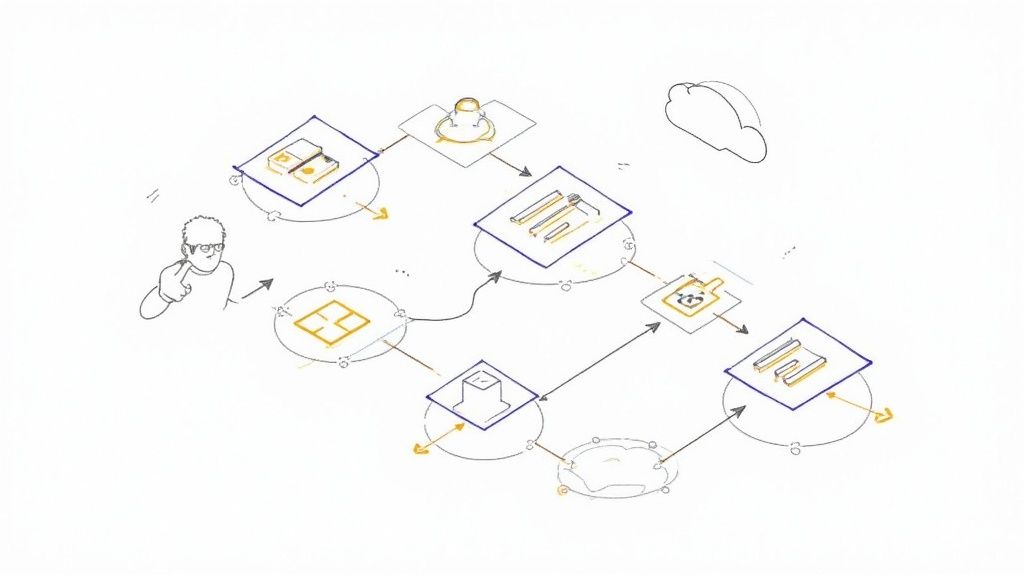
Elevate Your CI/CD Game with the Right Tools
Streamline your software delivery process with the right continuous delivery tools. This list of top 10 tools—including Mergify, Jenkins, GitLab CI/CD, Azure DevOps, GitHub Actions, CircleCI, TeamCity, AWS CodePipeline, Bamboo, and Spinnaker—will help you choose the platform that best suits your team and project. These tools tackle the complexities of automating builds, tests, and deployments, enabling faster releases and improved code quality. Learn about their key features, advantages, and disadvantages to optimize your CI/CD pipeline in 2025.
1. Mergify: Streamlining Your Merge Workflow for Continuous Delivery
In the fast-paced world of continuous delivery, automating repetitive tasks is crucial for maintaining speed and efficiency. Mergify emerges as a powerful continuous merge platform designed to optimize the code integration process, thereby boosting productivity and minimizing friction for software development teams. By automating merge workflows, managing pull request dependencies, and offering insightful CI analysis, Mergify allows developers to focus on what they do best: building great software. Its value proposition lies in simplifying complex merge scenarios, reducing CI costs, and enhancing the overall stability of the codebase. This makes Mergify a valuable tool for any team practicing continuous delivery and striving for a streamlined, automated development workflow.
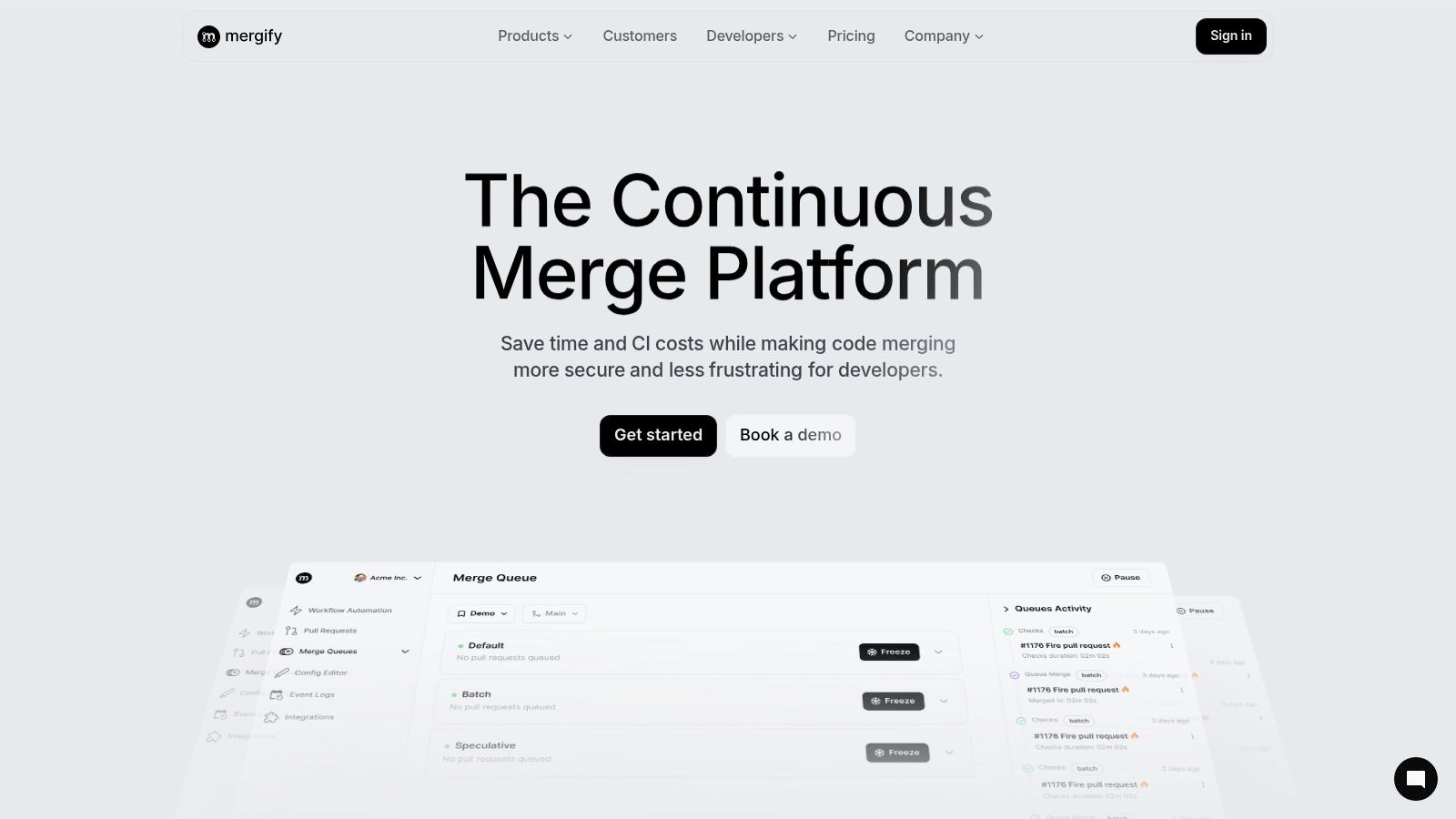
Mergify’s core functionality revolves around its intelligent merge queue and automated merge capabilities. Instead of manually merging pull requests and dealing with potential conflicts, developers can define specific conditions and rules within a YAML configuration file. These rules dictate how and when pull requests are merged, ensuring consistent workflows and adherence to project standards. For example, you can configure Mergify to automatically merge a pull request once all required checks pass and approvals are granted. More complex scenarios involving multiple interdependent pull requests are also handled efficiently, with Mergify automatically merging them in the correct order once all dependencies are met. This eliminates manual intervention, reduces the risk of human error, and accelerates the integration process.
One of Mergify's standout features is its CI Insights capability. This feature provides real-time visibility into the health of your CI pipelines, identifying bottlenecks and flaky tests that might be slowing down your release cycles. Using AI-powered analysis, CI Insights can pinpoint the root cause of issues, offering actionable alerts and recommendations for optimization. By proactively addressing these problems, teams can improve their CI performance and achieve faster, more reliable deployments. While this feature is currently in beta, its potential to significantly improve CI efficiency makes it a compelling aspect of the Mergify platform.
Compared to manual merge processes or basic merge bots, Mergify offers a far more sophisticated and comprehensive solution. While simple bots might automate basic merges, they often lack the flexibility and intelligence to handle complex scenarios or provide deep insights into CI performance. Mergify, on the other hand, empowers teams to define intricate merge strategies, manage dependencies, and gain valuable data-driven insights into their CI pipelines. This level of control and visibility sets it apart from other solutions in the continuous delivery tool landscape.
Implementing Mergify requires configuring a YAML file within your repository to define your merge rules and workflows. While this does involve a learning curve, especially for smaller teams without dedicated CI/CD engineers, the benefits in terms of automation and efficiency far outweigh the initial setup effort. The Mergify documentation provides extensive guidance and examples to assist with configuration, and the platform's intuitive interface simplifies the process.
Pricing: Mergify offers different pricing tiers, including a free plan for open-source projects and paid plans for private repositories, with pricing scaled based on the number of users and repositories. Specific pricing details are available on their website.
Technical Requirements: Mergify integrates seamlessly with popular Git providers like GitHub, GitLab, and Bitbucket.
Pros:
- Significantly reduces CI costs and developer frustration through intelligent merge automation and batching.
- Enhances code security and stability with automated merge queue and advanced merge protection rules.
- Innovative CI Insights feature provides real-time pipeline observability and AI-driven issue detection for faster problem resolution.
- Flexible and customizable workflow automation supports complex PR dependencies, scheduling, and enforcement of project standards.
- Proven track record with endorsements from engineering leaders at startups and enterprises, highlighting improved team efficiency and reduced manual work.
Cons:
- CI Insights is currently in beta, so some advanced analytics features may still be evolving.
- Setup requires some initial configuration of YAML rules and workflows, which may have a learning curve for smaller teams without dedicated CI/CD engineers.
Website: https://mergify.com
Mergify is a powerful tool for any team serious about optimizing their continuous delivery pipeline. Its intelligent automation, insightful CI analysis, and flexible configuration options make it a valuable asset for streamlining workflows, reducing costs, and accelerating releases. While there's a slight learning curve with the YAML configuration, the long-term benefits in terms of improved developer productivity and code stability make Mergify a worthy investment for any software development team.
2. Jenkins
Jenkins is a venerable open-source automation server that stands as a cornerstone in the world of continuous delivery and continuous integration (CI/CD). Its robust features and extensive plugin ecosystem have made it a popular choice for automating various aspects of the software development lifecycle, from building and testing to deploying and releasing. Jenkins empowers developers to establish efficient and reliable CI/CD pipelines, ensuring rapid and consistent delivery of high-quality software. Its flexibility makes it adaptable to a wide range of project sizes and complexities, making it a valuable tool for individual developers and large enterprise teams alike. It deserves a place on this list due to its maturity, vast community support, and unparalleled extensibility, making it a powerful and versatile choice for implementing continuous delivery.
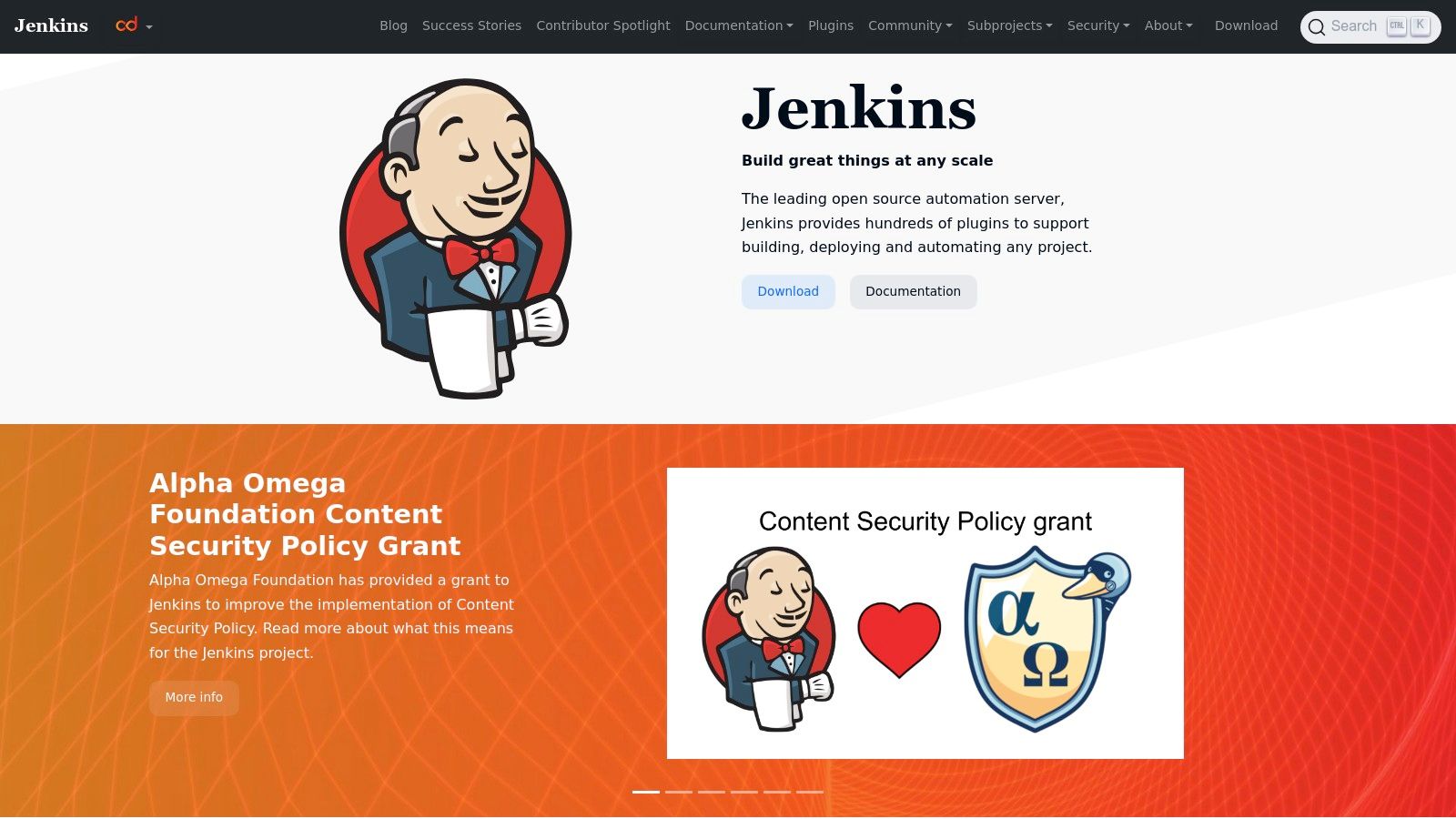
One of Jenkins's key strengths lies in its "Pipeline-as-code" functionality, enabled through Jenkinsfile. This allows developers to define their entire CI/CD workflow as code, stored alongside their project's source code. This approach offers several benefits, including version control, improved collaboration, and enhanced reproducibility of the pipeline. Jenkins supports both declarative and scripted pipeline syntax, providing flexibility to define pipelines in a way that best suits the project’s needs. The declarative syntax offers a more structured and simplified approach, while the scripted syntax offers greater flexibility and power for complex scenarios. You can learn more about Jenkins and how it can optimize your CI/CD pipeline in this insightful article.
Jenkins boasts an unparalleled plugin ecosystem with over 1,800 plugins. This extensive library allows teams to integrate Jenkins with virtually every tool in the DevOps toolchain, extending its functionality to cover a wide range of build tools, testing frameworks, deployment platforms, and notification systems. This level of integration streamlines workflows and enables seamless automation across the entire development process. Need to integrate with Docker? There's a plugin for that. Need to connect to Kubernetes? There's a plugin for that too. This plugin-based architecture allows Jenkins to adapt to the evolving needs of a project without requiring extensive custom scripting.
For larger projects, Jenkins supports distributed builds using a master-slave architecture. This enables distributing the workload across multiple machines, significantly reducing build times and improving overall efficiency. The master node orchestrates the builds and distributes tasks to the slave nodes, ensuring that the build process is scalable and can handle even the most demanding projects. This distributed architecture is particularly beneficial for organizations with large codebases or complex build processes.
While Jenkins offers a wealth of powerful features, it does come with its own set of challenges. Configuring complex pipelines can be daunting for newcomers, requiring a significant investment in learning the tool's intricacies. Furthermore, maintaining and administering a Jenkins server can be time-consuming, especially for larger deployments. Keeping plugins updated and ensuring server stability demands ongoing effort. The UI, while functional, can feel dated compared to more modern alternatives. Finally, the sheer number of plugins, while a strength, can sometimes lead to compatibility issues, requiring careful selection and management.
Despite these challenges, Jenkins remains a powerful and widely adopted continuous delivery tool. Its open-source nature, extensibility, and massive community support make it a valuable asset for organizations of all sizes. Being free to use, Jenkins eliminates licensing costs, making it an accessible option for startups and individual developers. It runs on virtually any operating system, offering platform agnosticism and flexibility in deployment options. Whether you’re a small team just beginning your CI/CD journey or a large enterprise looking for a robust and customizable solution, Jenkins offers the features and flexibility to automate your delivery pipeline effectively. While the learning curve can be steep, the long-term benefits in terms of improved efficiency, faster releases, and higher quality software make it a worthwhile investment.
3. GitLab CI/CD
GitLab CI/CD is a robust, integrated continuous integration and continuous delivery platform built directly into the GitLab source code management system. This tight integration offers a compelling advantage, providing development teams with a unified platform for managing the entire software development lifecycle, from planning and coding to testing, deployment, and monitoring. This eliminates the need for disparate tools and simplifies the process, making GitLab CI/CD a strong contender amongst continuous delivery tools. It effectively streamlines workflows, fosters collaboration, and accelerates the delivery of high-quality software. GitLab offers both cloud-hosted (GitLab SaaS) and self-managed options, giving organizations flexibility in deployment based on their specific needs and security requirements. Its robust Docker integration makes it particularly well-suited for containerized applications and modern microservices architectures.
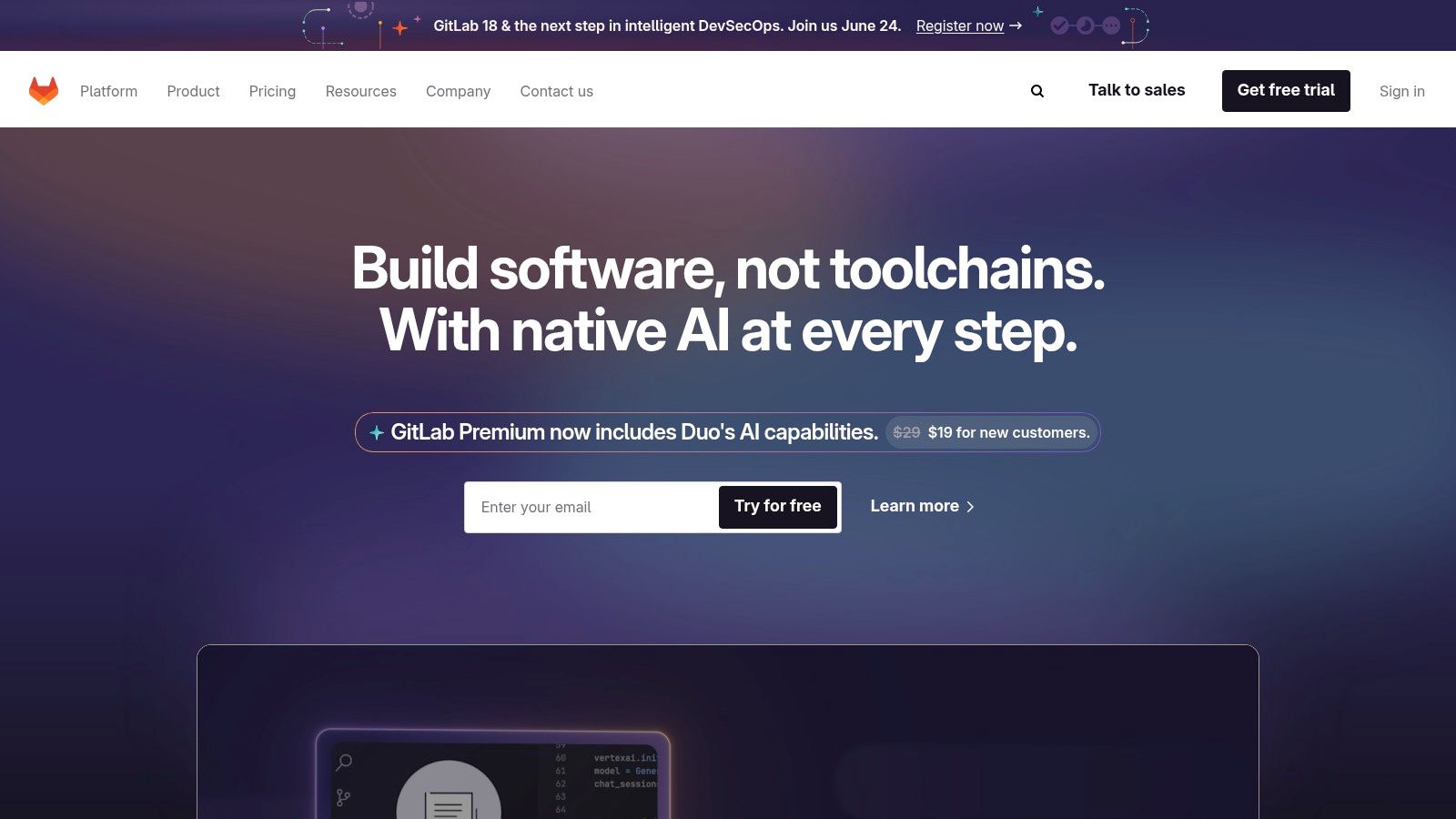
One of GitLab CI/CD's most powerful features is Auto DevOps. This feature automatically configures CI/CD pipelines based on best practices, significantly reducing the setup time and effort required to get started with continuous integration and delivery. This is especially beneficial for teams new to CI/CD or those looking to quickly implement pipelines for new projects. For more complex scenarios, GitLab CI/CD allows for fine-grained control over pipeline definitions using a YAML configuration file (.gitlab-ci.yml), enabling teams to customize their workflows to meet specific project requirements. You can even delve deeper into pipeline configuration with resources like this guide on GitLab CI variables: Learn more about GitLab CI/CD.
GitLab CI/CD's built-in container registry and Kubernetes integration further simplify the deployment process. The container registry allows for seamless storage and management of Docker images, while the Kubernetes integration facilitates automated deployments to Kubernetes clusters. This streamlined workflow accelerates the delivery of containerized applications and allows for efficient scaling and management of deployments. Furthermore, GitLab CI/CD includes security scanning and compliance features, enabling teams to identify and address vulnerabilities early in the development lifecycle. These features help ensure the delivery of secure and compliant software.
While GitLab CI/CD offers numerous advantages, there are some potential drawbacks to consider. Self-hosted instances can be resource-intensive, requiring significant server capacity and maintenance effort. Compared to highly specialized CI tools like Jenkins, GitLab CI/CD might offer slightly less flexibility in certain edge cases. Although a generous free tier is available, pricing for advanced features can be steep, particularly for larger organizations. Finally, the ecosystem of third-party integrations, while growing, is not as extensive as that of Jenkins.
From a pricing perspective, GitLab offers various tiers, ranging from a free version with limited features to premium enterprise plans with advanced features and support. The free tier is quite generous, providing a substantial number of CI/CD minutes and storage, making it a viable option for small teams and open-source projects. Paid plans offer additional features such as advanced security testing, compliance features, and priority support. Technical requirements for self-hosted instances vary depending on the scale of the deployment and the features used. GitLab provides detailed documentation outlining the recommended hardware and software requirements.
Compared to similar continuous delivery tools like Jenkins and CircleCI, GitLab CI/CD stands out with its all-in-one approach. Jenkins, known for its extensive plugin ecosystem and flexibility, often requires integrating multiple tools, leading to increased complexity. CircleCI, while offering a cloud-based solution with good performance, lacks the comprehensive DevOps platform that GitLab provides. The integrated nature of GitLab CI/CD simplifies toolchain management, enhances collaboration, and reduces context switching, ultimately leading to faster development cycles and quicker delivery of software.
Implementing GitLab CI/CD typically involves creating a .gitlab-ci.yml file in the root directory of your project. This file defines the stages and jobs that comprise your CI/CD pipeline. Each job specifies the commands to be executed, the Docker image to use, and any necessary dependencies. GitLab provides extensive documentation and examples to assist with setting up and configuring pipelines for various use cases. For initial setup, leveraging the Auto DevOps feature can be a great starting point. This provides a pre-configured pipeline based on best practices, allowing teams to quickly get started with CI/CD and then customize as needed. Carefully planning your pipeline stages and jobs, and utilizing GitLab's robust features for artifact management and deployment, can greatly enhance your CI/CD workflow. Remember to monitor your pipeline performance and adjust configurations as needed to optimize efficiency.
4. Azure DevOps
Azure DevOps is a robust continuous delivery tool offered by Microsoft, providing a comprehensive suite of services designed to streamline the software development lifecycle. It's more than just a CI/CD pipeline orchestrator; it's a complete platform encompassing everything from code repositories and project management tools to artifact repositories and testing frameworks. This makes it an attractive option for teams looking for an all-in-one solution that tightly integrates with the Microsoft ecosystem. This breadth of functionality contributes significantly to its position as a leading continuous delivery tool. Azure DevOps allows teams to automate builds, testing, and deployments, enabling faster release cycles and higher-quality software. It supports a wide range of platforms and programming languages, making it adaptable to diverse development environments. Its powerful features empower teams to build, test, and deploy software with speed and confidence.
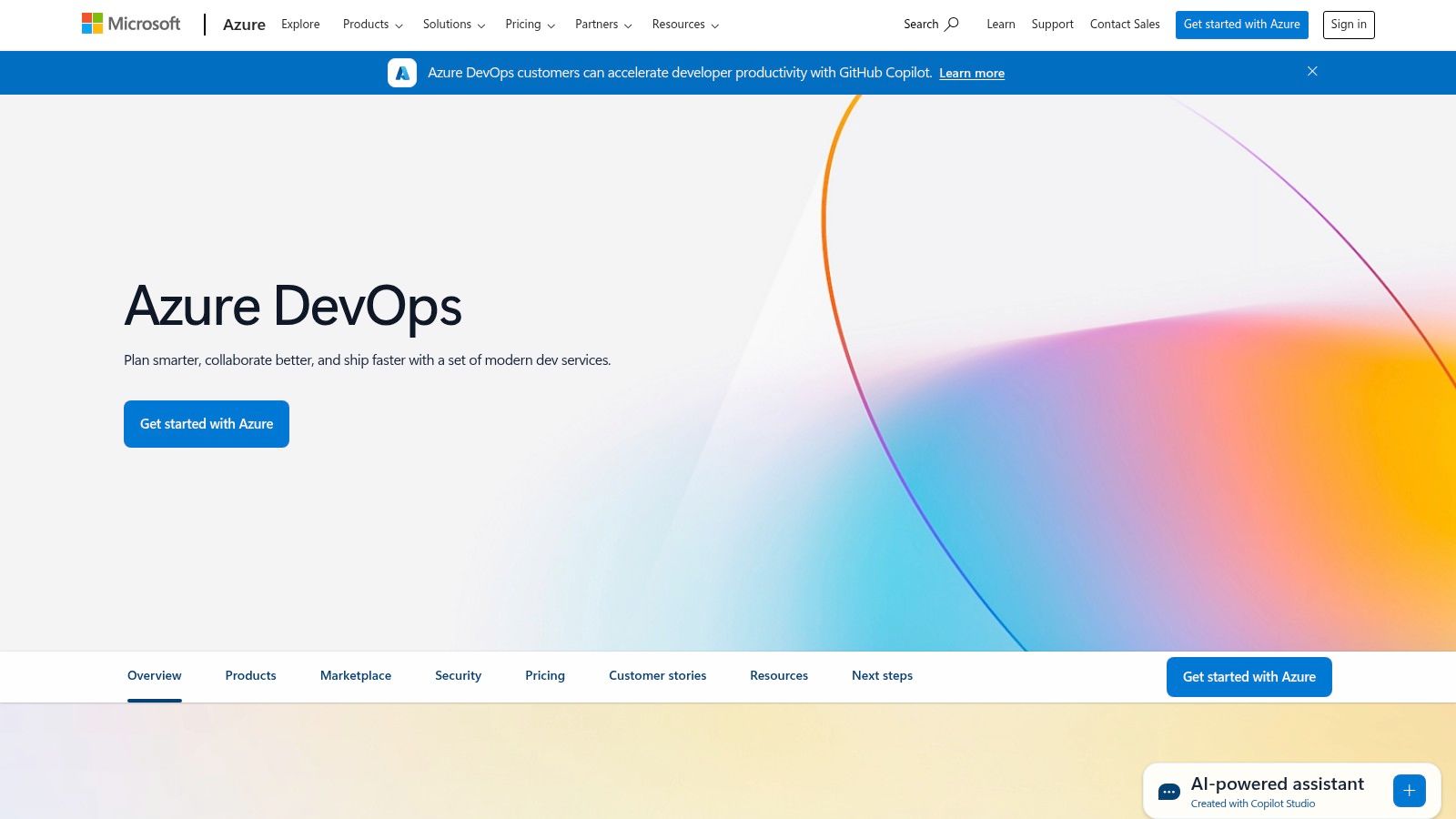
At the heart of Azure DevOps is Azure Pipelines, its powerful continuous integration and continuous delivery service. Pipelines allow you to define your build and release workflows using YAML configuration, offering a code-as-infrastructure approach that promotes version control and automation best practices. This YAML-based system allows for complex pipeline definitions, supporting various build tools, testing frameworks, and deployment targets. Azure DevOps’ multi-platform support – including Windows, Linux, and macOS – further broadens its applicability across different development environments. For teams heavily reliant on the Microsoft ecosystem, Azure DevOps offers seamless integration with Azure cloud services, making deployments to Azure platforms remarkably efficient. Built-in artifact management and package feeds simplify dependency management, promoting code reuse and minimizing integration headaches.
Beyond CI/CD, Azure DevOps provides robust project management capabilities with Azure Boards. Teams can utilize Kanban boards, Scrum boards, or custom workflows to track work items, manage sprints, and visualize project progress. This integrated approach fosters better collaboration and communication within development teams, ultimately contributing to smoother and more predictable releases. Azure Artifacts, the integrated package management solution, allows you to create private package feeds for hosting and sharing dependencies within your organization, ensuring consistent and reliable access to software components.
While Azure DevOps offers a compelling package for continuous delivery, it's essential to consider its strengths and weaknesses. One of the key advantages is its tight integration with the Microsoft ecosystem, making it a natural choice for organizations already invested in Azure cloud services and other Microsoft tools. A generous free tier, offering 1,800 build minutes per month, allows teams to experiment and get started without a significant upfront investment. Strong Windows and .NET support is another highlight, reflecting Microsoft's core strengths. Finally, having a comprehensive DevOps toolset within a single platform simplifies toolchain management and reduces context switching for developers.
However, Azure DevOps can feel complex for smaller projects or simpler use cases. The extensive feature set, while powerful, can introduce a steeper learning curve for teams new to the platform. While it supports multiple platforms, it undeniably shines brightest in Microsoft-centric environments. Customization options, while present, can be more limited compared to some open-source alternatives like Jenkins. Finally, pricing can escalate quickly for larger teams with extensive build and deployment needs, requiring careful cost management.
Implementing Azure DevOps typically involves creating an Azure DevOps organization, setting up projects within the organization, and configuring Azure Repos to host your source code. You then define your CI/CD pipelines using YAML files, specifying the build steps, testing procedures, and deployment targets. Connecting to your Azure subscription allows for seamless deployments to Azure services. Plenty of documentation and tutorials are available on the Microsoft website to guide you through the setup and configuration process.
For organizations deeply embedded in the Microsoft ecosystem, Azure DevOps offers an appealing all-in-one solution for continuous delivery. Its comprehensive features, tight Azure integration, and robust project management capabilities make it a powerful tool for accelerating software development and improving delivery efficiency. However, teams should carefully consider their specific needs and evaluate the potential complexities and cost implications before committing to a full-scale implementation. More information and documentation can be found on the Azure DevOps website.
5. GitHub Actions
GitHub Actions is a powerful continuous integration and continuous delivery (CI/CD) platform built directly into GitHub. This native integration makes it incredibly convenient for developers already using GitHub for version control, as it eliminates the need for third-party CI/CD tools and simplifies workflow management. GitHub Actions allows you to automate build, test, and deployment pipelines directly within your repositories, streamlining the development process and enabling faster releases. It's an excellent continuous delivery tool for projects of all sizes, from individual developers to large enterprise teams.

One of the key strengths of GitHub Actions lies in its flexibility and extensibility. Workflows are defined using YAML files, making them easily version-controlled and customizable. These workflows can be triggered by a variety of GitHub events, such as pushes, pull requests, or issue creation, allowing for automation at every stage of the development lifecycle. For instance, you could configure a workflow to automatically run tests upon every push to the main branch, ensuring code quality and preventing regressions. Another workflow could be set up to automatically deploy your application to a staging environment upon the creation of a release. This automation significantly reduces manual effort and accelerates the feedback loop, allowing developers to identify and address issues quickly.
Furthermore, GitHub Actions boasts a vast marketplace of pre-built actions, contributed by both GitHub and the community. These pre-built actions cover a wide range of tasks, from building and testing code to deploying to various cloud platforms. This extensive library of actions makes it easy to assemble complex workflows without having to write everything from scratch. Need to deploy your application to AWS? There's an action for that. Want to run code analysis with SonarQube? There's an action for that too. This readily available ecosystem of reusable components significantly reduces development time and simplifies the process of implementing best practices in your CI/CD pipelines.
Another valuable feature is the matrix builds capability. Matrix builds allow you to test your code across multiple operating systems, different versions of programming languages, and various dependencies simultaneously. This ensures your application functions correctly in diverse environments, reducing compatibility issues and improving overall software quality.
For teams requiring more control over their build environments, GitHub Actions also supports self-hosted runners. This allows you to run workflows on your own infrastructure, providing greater flexibility and control over security and compliance requirements. This is particularly useful for organizations with strict internal policies or specialized hardware needs.
While GitHub Actions offers a generous free tier of 2,000 minutes per month for private repositories, heavy usage can lead to increased costs. It's crucial to monitor usage and optimize workflows to avoid unexpected expenses, especially for large projects or organizations with many repositories. Another potential drawback is vendor lock-in to the GitHub ecosystem. While this tight integration is a benefit for existing GitHub users, it may not be ideal for organizations using other version control systems. For more complex enterprise workflows, other dedicated CI/CD platforms might offer greater flexibility and customization options.
Learn more about GitHub Actions to delve into security best practices within your CI/CD pipelines. Implementing robust security measures within your automated workflows is crucial for protecting your code and infrastructure.
Compared to similar tools like GitLab CI/CD or CircleCI, GitHub Actions stands out with its seamless integration with the GitHub platform. While other platforms offer comparable features like YAML-based workflows and pre-built integrations, the native experience within GitHub simplifies context switching and streamlines development workflows. For teams already heavily invested in the GitHub ecosystem, Actions often presents the most convenient and integrated solution.
Setting up GitHub Actions is straightforward. Workflows are defined in YAML files placed in the .github/workflows directory within your repository. This ensures that your CI/CD configuration is version-controlled alongside your code. Each workflow consists of a series of jobs, which in turn are composed of individual steps. These steps can be actions from the marketplace, custom scripts, or commands. The simplicity of the YAML syntax makes it easy to define and manage even complex workflows.
GitHub Actions is a robust and versatile continuous delivery tool that empowers development teams to automate their workflows and accelerate the software delivery process. Its seamless integration with GitHub, extensive marketplace of actions, and flexible workflow configuration make it a compelling choice for projects of all sizes. However, be mindful of potential vendor lock-in and the potential for increased costs with heavy usage.
6. CircleCI: A Cloud-Native Powerhouse for Continuous Delivery
CircleCI is a prominent player in the continuous delivery tools landscape, known for its cloud-native architecture, speed, and efficiency. It offers a compelling blend of features designed to accelerate the software development lifecycle, making it a popular choice for teams looking to streamline their build, test, and deployment processes. As a continuous delivery tool, CircleCI empowers development teams to automate their workflows, enabling faster releases and improved collaboration. This cloud-based platform excels at simplifying complex delivery pipelines and ensuring code quality.
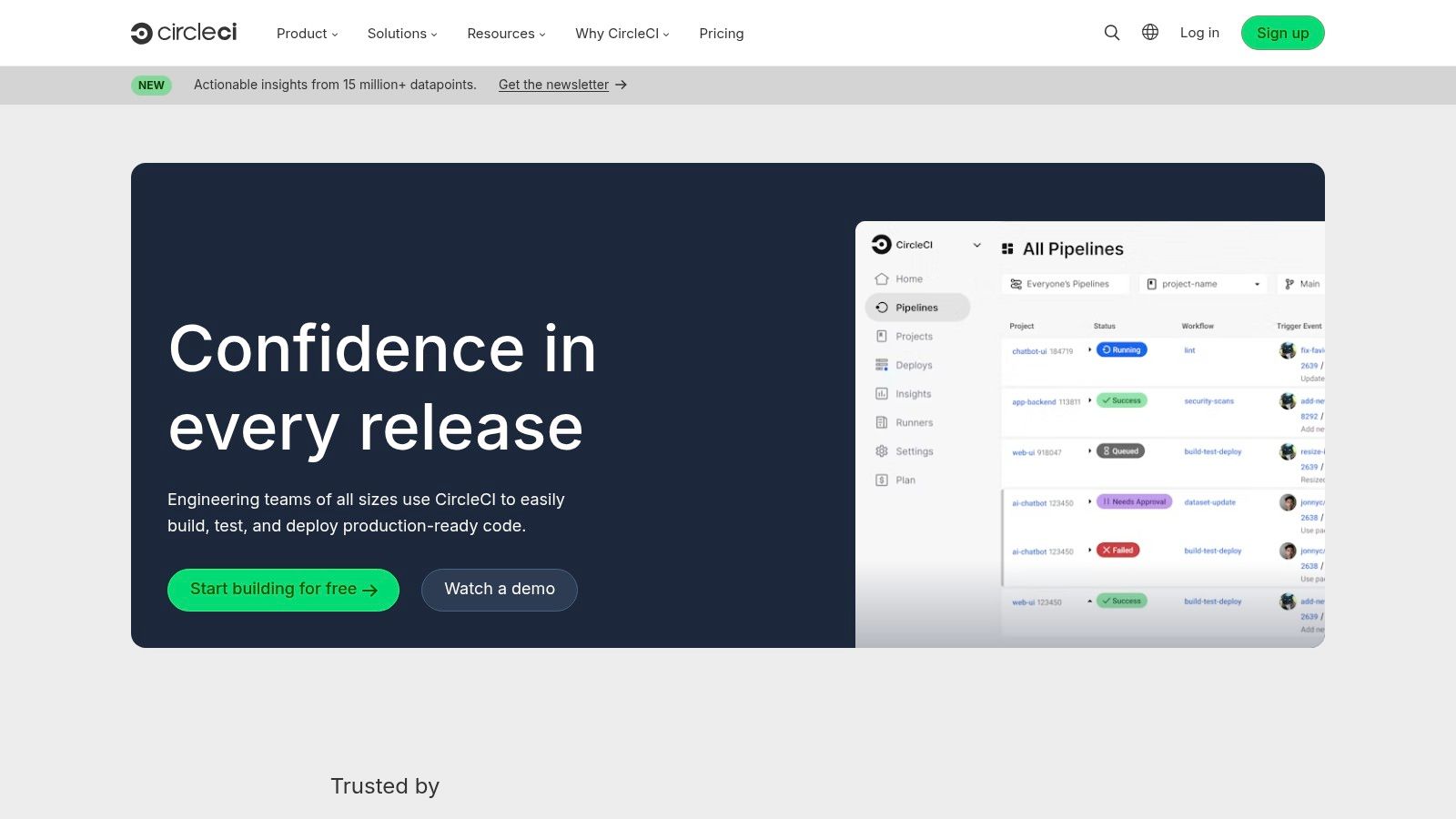
One of CircleCI's core strengths lies in its advanced caching mechanisms and parallelism. These features significantly reduce build times, allowing teams to iterate more rapidly. By intelligently caching build artifacts and dependencies, CircleCI avoids redundant computations, saving precious development time. Furthermore, its parallel execution capabilities allow for concurrent testing across multiple environments, further accelerating the feedback loop. Its Docker-first approach means builds run in isolated containers, ensuring consistency and reproducibility across different development stages. This containerized approach streamlines dependency management and simplifies the build process, particularly for microservice architectures.
CircleCI's workflow orchestration capabilities provide fine-grained control over the continuous delivery pipeline. Teams can define complex job dependencies, ensuring that specific tasks are executed in the correct order and only when necessary. This allows for highly customized workflows tailored to the specific needs of each project. For instance, you can configure workflows to run unit tests before integration tests, followed by deployment to a staging environment upon successful completion. This granular control ensures that code changes are thoroughly vetted before reaching production.
Beyond automation, CircleCI facilitates effective debugging. The platform offers SSH debugging for failed builds, allowing developers to directly access the build environment and investigate issues. This feature proves invaluable in identifying the root cause of build failures and quickly resolving them. Additionally, CircleCI's "Orbs" feature provides reusable configuration packages, promoting consistency and best practices across projects. These orbs encapsulate common CI/CD tasks and integrations, reducing boilerplate code and simplifying workflow configuration.
Comparing CircleCI to similar continuous delivery tools like GitLab CI/CD and Jenkins, CircleCI stands out for its ease of use and cloud-native nature. While Jenkins offers greater flexibility and customization, particularly for on-premise deployments, it often requires more extensive configuration and maintenance. GitLab CI/CD tightly integrates with the GitLab ecosystem, making it a natural choice for teams already using GitLab for version control. However, CircleCI's focus on speed and optimization through features like caching and parallelism often gives it a performance edge, especially for complex projects.
Implementation and setup tips: Getting started with CircleCI is generally straightforward. Connecting your version control system (e.g., GitHub, Bitbucket) to CircleCI is the first step. Then, you define a configuration file (.circleci/config.yml) in your project's root directory. This file specifies the build environment, steps involved in the build process, testing procedures, and deployment instructions. CircleCI's documentation and extensive library of Orbs simplify the configuration process.
Pricing and Technical Requirements: CircleCI offers a free tier suitable for open-source projects and small teams. For private repositories and larger teams, paid plans provide increased resources and features like larger build instances, more concurrent builds, and access to premium support. While the free tier is generous, the pricing for larger teams can become a considerable factor. In terms of technical requirements, CircleCI operates as a cloud service, so there are no specific hardware or software requirements beyond a web browser and access to a version control system.
Pros:
- Excellent performance and build speed thanks to advanced caching and parallelism
- Strong Docker support and container optimization
- Intuitive web interface and easy setup
- Good free tier for open-source projects
- Robust workflow orchestration and Orbs for reusable configuration
Cons:
- Limited free tier for private repositories
- Pricing can be expensive for larger teams
- Less customizable than self-hosted solutions like Jenkins
- Debugging complex workflows can sometimes be challenging
Website: https://circleci.com/
CircleCI earns its place on this list of continuous delivery tools due to its cloud-native design, focus on speed, and robust feature set. Its powerful caching, parallelism, and Docker integration make it a compelling choice for teams seeking to optimize their CI/CD pipelines and accelerate the delivery of high-quality software. While the pricing model may require careful consideration for larger teams, the benefits in terms of speed and efficiency often outweigh the cost, especially for organizations prioritizing rapid iteration and continuous improvement.
7. TeamCity
TeamCity, developed by JetBrains, is a robust on-premises continuous integration and continuous delivery (CI/CD) server that stands out for its powerful build management capabilities and intuitive user interface. It’s a popular choice amongst development teams looking for a comprehensive solution to automate their build, test, and deployment pipelines. Its strength lies in handling complex build chains and providing a seamless experience for managing even the most intricate projects. This makes it a worthy contender in the landscape of continuous delivery tools.
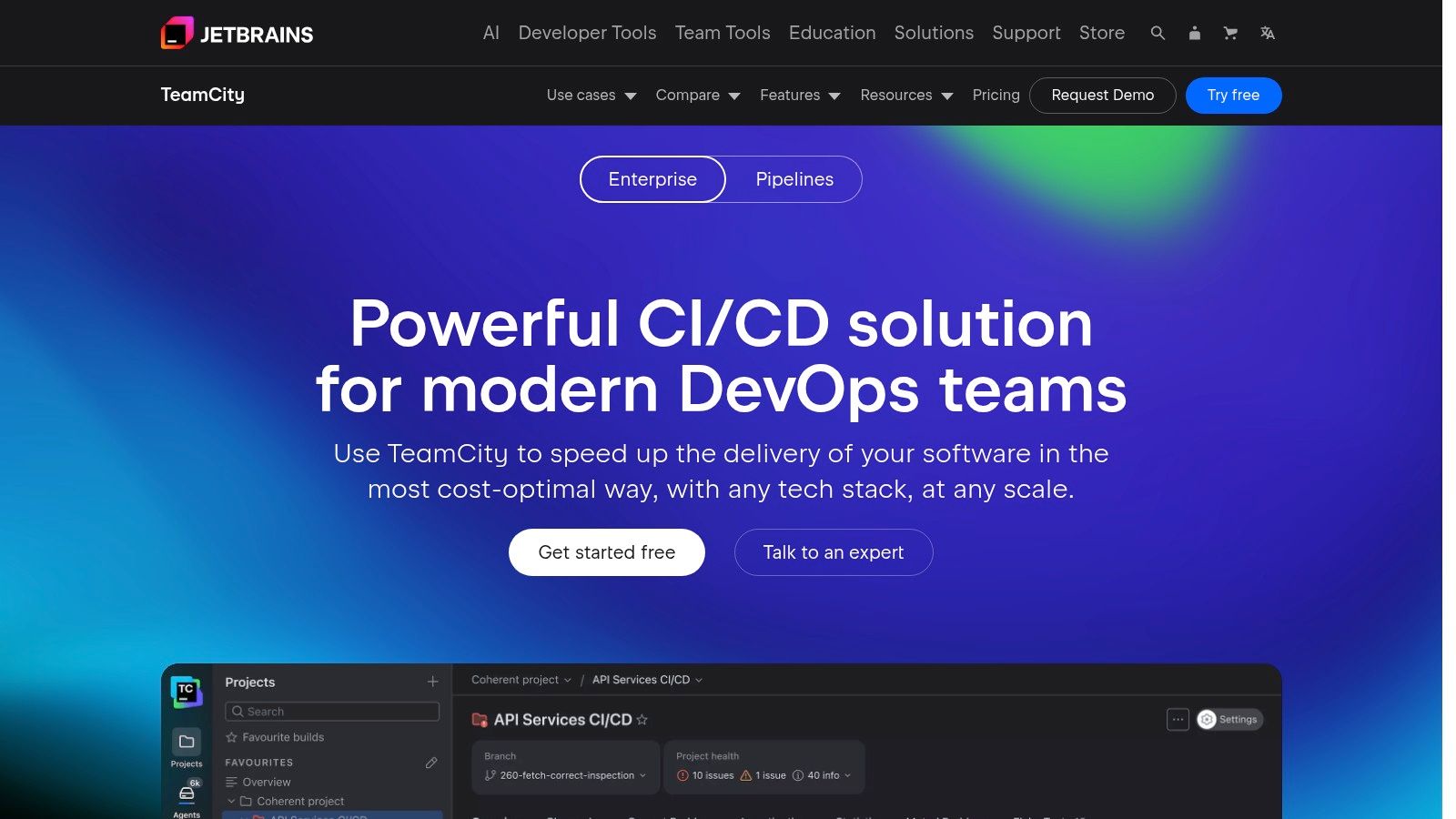
TeamCity excels in orchestrating sophisticated build pipelines with its intelligent build chains and dependency management. Imagine a scenario where your project involves multiple components, each with its own build process. TeamCity allows you to define dependencies between these components, ensuring that they are built in the correct order and only when their dependencies are successfully built. This significantly simplifies managing complex projects and reduces the risk of integration issues. Furthermore, its advanced build grid functionality allows you to distribute builds across multiple agents, drastically reducing build times and accelerating your development cycle.
A key advantage of TeamCity is its comprehensive integration with a wide array of Version Control Systems (VCS), including Git, Subversion, and Mercurial. Its intelligent change detection mechanism automatically triggers builds based on code commits, keeping your builds up-to-date with the latest changes. This is critical for maintaining a rapid development pace and ensuring that integration issues are caught early. Beyond VCS integration, TeamCity boasts built-in support for various code coverage and testing frameworks, enabling you to seamlessly integrate automated testing into your continuous delivery pipeline. The flexible notification and reporting system provides real-time feedback on build status and test results, keeping your team informed and empowered to address issues promptly.
For smaller teams with up to 100 build configurations and three build agents, TeamCity offers a free Professional Server License. This allows teams to experience the power and flexibility of TeamCity without incurring upfront costs. For larger teams and more demanding projects, an Enterprise Server License is available, offering unlimited build configurations and agents. The pricing for the Enterprise Server License is tiered based on the number of agents required, starting at $299/year for 3 agents. This tiered pricing structure provides flexibility for organizations of all sizes to tailor their TeamCity implementation to their specific needs and budget.
In terms of technical requirements, TeamCity runs on a variety of operating systems, including Windows, Linux, and macOS. It requires a Java Runtime Environment (JRE) and a relational database such as MySQL, PostgreSQL, or SQL Server. Setting up TeamCity involves installing the server, configuring the database, and connecting to your VCS. While primarily an on-premises solution, TeamCity can be deployed to cloud platforms, but it requires more configuration and maintenance compared to cloud-native CI/CD tools.
Compared to other continuous delivery tools like Jenkins and GitLab CI/CD, TeamCity shines with its user-friendly interface and superior build management capabilities. While Jenkins offers extensive plugin support and flexibility, it can be more complex to configure and manage, especially for larger projects. GitLab CI/CD integrates tightly with the GitLab platform, providing a streamlined experience for teams already using GitLab. However, TeamCity’s strength lies in its robust build chain management and ease of use, making it an excellent choice for teams prioritizing a powerful and intuitive CI/CD solution.
One potential drawback of TeamCity is its primary focus on on-premises deployments, requiring dedicated server resources and ongoing maintenance. While cloud deployments are possible, they are not as seamless as with cloud-native solutions. The cost of licensing for larger teams can also be a factor, as the price scales with the number of agents. Finally, when compared to modern cloud-native CI/CD tools, TeamCity's cloud-native features are somewhat limited, making it less suitable for organizations deeply invested in cloud-native architectures.
Despite these limitations, TeamCity remains a powerful and user-friendly continuous delivery tool, especially well-suited for teams working on complex projects with intricate build processes. Its excellent user interface, powerful build management capabilities, and strong integrations make it a valuable addition to any development workflow. For those seeking a robust on-premises solution with an emphasis on build management and ease of use, TeamCity (https://www.jetbrains.com/teamcity/) is definitely a strong contender.
8. AWS CodePipeline
AWS CodePipeline is a fully managed continuous delivery service that helps automate the build, test, and deployment phases of your release processes. As a core component of the AWS DevOps ecosystem, it provides a robust and scalable solution for teams looking to streamline their software delivery workflows. By orchestrating these critical stages, CodePipeline enables faster and more reliable releases, ultimately contributing to accelerated time-to-market and improved software quality. Its tight integration with other AWS services makes it a particularly attractive option for organizations already invested in the AWS cloud. For teams seeking a comprehensive continuous delivery solution tightly integrated with the AWS ecosystem, CodePipeline is a compelling choice among continuous delivery tools.
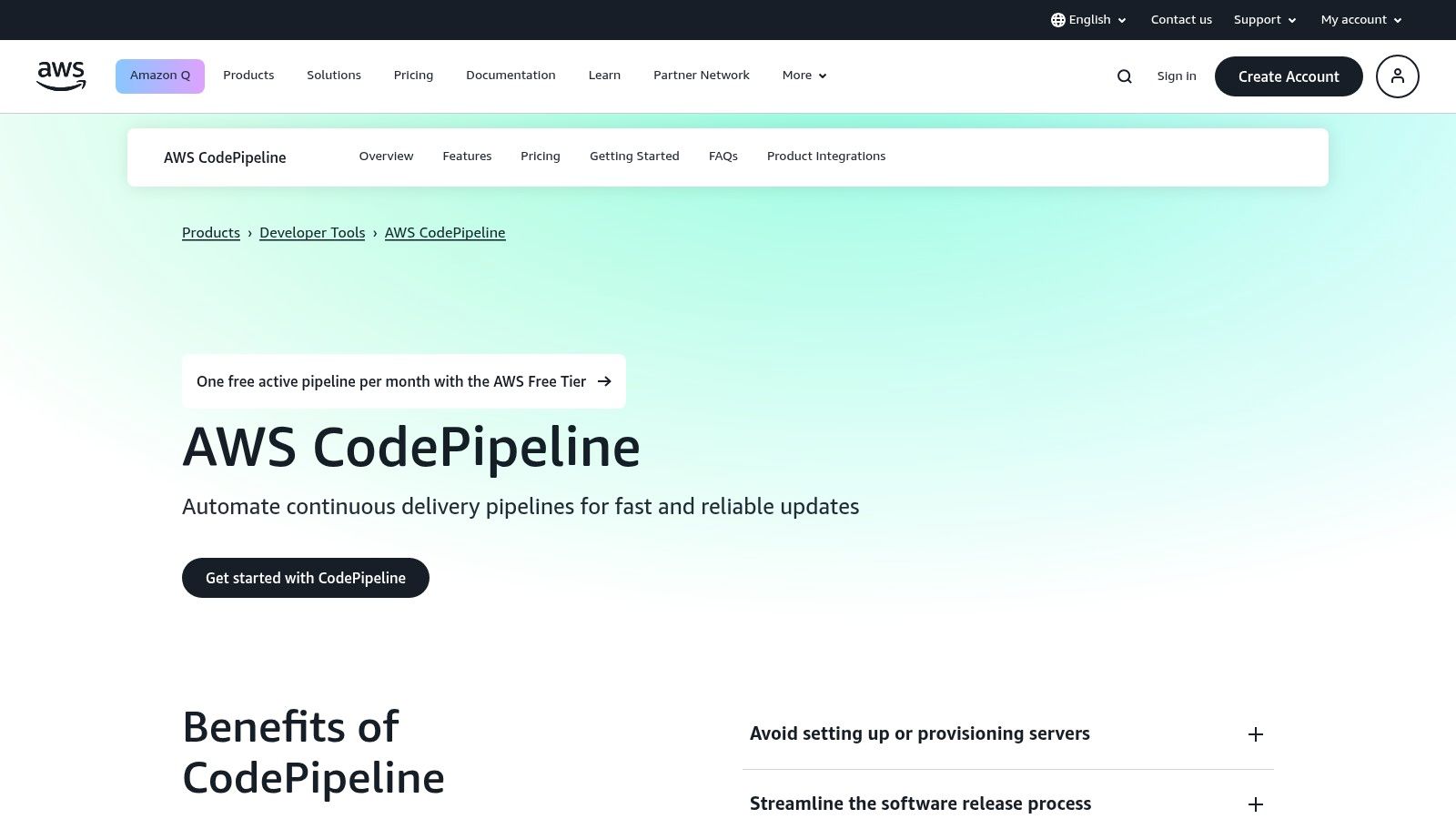
One of the key strengths of CodePipeline lies in its visual pipeline designer. The drag-and-drop interface simplifies the process of creating and managing complex release pipelines, enabling teams to define stages, actions, and transitions with ease. This visual representation promotes clarity and collaboration, making it easier for team members to understand and contribute to the continuous delivery process. Furthermore, CodePipeline supports both parallel and sequential action execution, allowing for optimized workflows that cater to various deployment scenarios.
CodePipeline shines in its native integration with other AWS services. It seamlessly connects with services like AWS CodeBuild for building code, AWS CodeDeploy for deploying applications, and AWS CodeCommit for source control. This tight integration allows for a unified and streamlined workflow within the AWS ecosystem, simplifying management and reducing complexity. Furthermore, CodePipeline also supports integrations with third-party tools like GitHub and Jenkins, offering flexibility for teams using a hybrid approach to their continuous delivery pipeline. This versatility allows you to incorporate existing tools and processes, minimizing disruption during migration or integration.
For organizations concerned about compliance and security, CodePipeline offers features like manual approval gates, allowing for human intervention at critical stages of the release process. This feature ensures that deployments are reviewed and authorized before proceeding, minimizing the risk of unintended releases. Additionally, CodePipeline supports automated rollback capabilities, providing a safety net in case of deployment failures. This allows teams to quickly revert to a previous stable version, mitigating the impact of errors and ensuring continuous availability.
Practical Applications and Use Cases:
- Web Application Deployment: Automating the build, testing, and deployment of web applications to AWS services like Elastic Beanstalk, ECS, or S3.
- Mobile Application Releases: Streamlining the release process for mobile apps by automating build processes, running tests, and distributing builds to app stores.
- Infrastructure as Code: Integrating with AWS CloudFormation to automate the provisioning and management of infrastructure resources as part of the continuous delivery pipeline.
- Serverless Application Deployment: Automating the deployment and updating of serverless applications using AWS Lambda and API Gateway.
Pricing and Technical Requirements:
CodePipeline follows a pay-as-you-go pricing model. You are charged a fixed price per active pipeline per month. The pricing is relatively inexpensive for infrequent pipeline executions but can become a considerable factor for organizations with high-frequency deployments. Technically, CodePipeline requires an AWS account and appropriate IAM permissions for access and management.
Comparison with Similar Tools:
Compared to tools like Jenkins or Azure DevOps, CodePipeline's deep integration with the AWS ecosystem is a significant differentiator. While Jenkins offers greater flexibility and customization, CodePipeline provides a more managed and serverless experience, reducing operational overhead. Azure DevOps, while comparable in features, is naturally more focused on the Microsoft Azure ecosystem.
Implementation and Setup Tips:
- Start with a simple pipeline and gradually add complexity as needed.
- Leverage the visual pipeline designer for easier management.
- Utilize native AWS service integrations where possible.
- Implement manual approval gates for critical deployments.
- Configure automated rollback capabilities for enhanced safety.
Website: https://aws.amazon.com/codepipeline/
CodePipeline's fully managed nature, visual workflow designer, and tight integration with the AWS ecosystem make it a valuable tool for organizations seeking a streamlined and efficient continuous delivery solution. While it might have limitations outside the AWS environment and can become expensive for frequent executions, its ease of use and powerful features justify its inclusion among the top continuous delivery tools available. For teams operating primarily within the AWS cloud, CodePipeline is a strong contender for automating and optimizing the software delivery lifecycle.
9. Bamboo
Atlassian's Bamboo is a powerful continuous integration and continuous delivery (CD) server designed to automate the software delivery pipeline, from building and testing to deployment. It stands out due to its tight integration with other Atlassian products like Jira for issue tracking and Confluence for documentation, creating a unified ecosystem for software development and operations. While it offers robust features and a user-friendly interface, potential users should be aware of the licensing costs and consider whether the Atlassian ecosystem aligns with their existing toolset. Bamboo earns its place on this list of continuous delivery tools for its comprehensive features, strong enterprise focus, and seamless integration with the popular Atlassian suite.
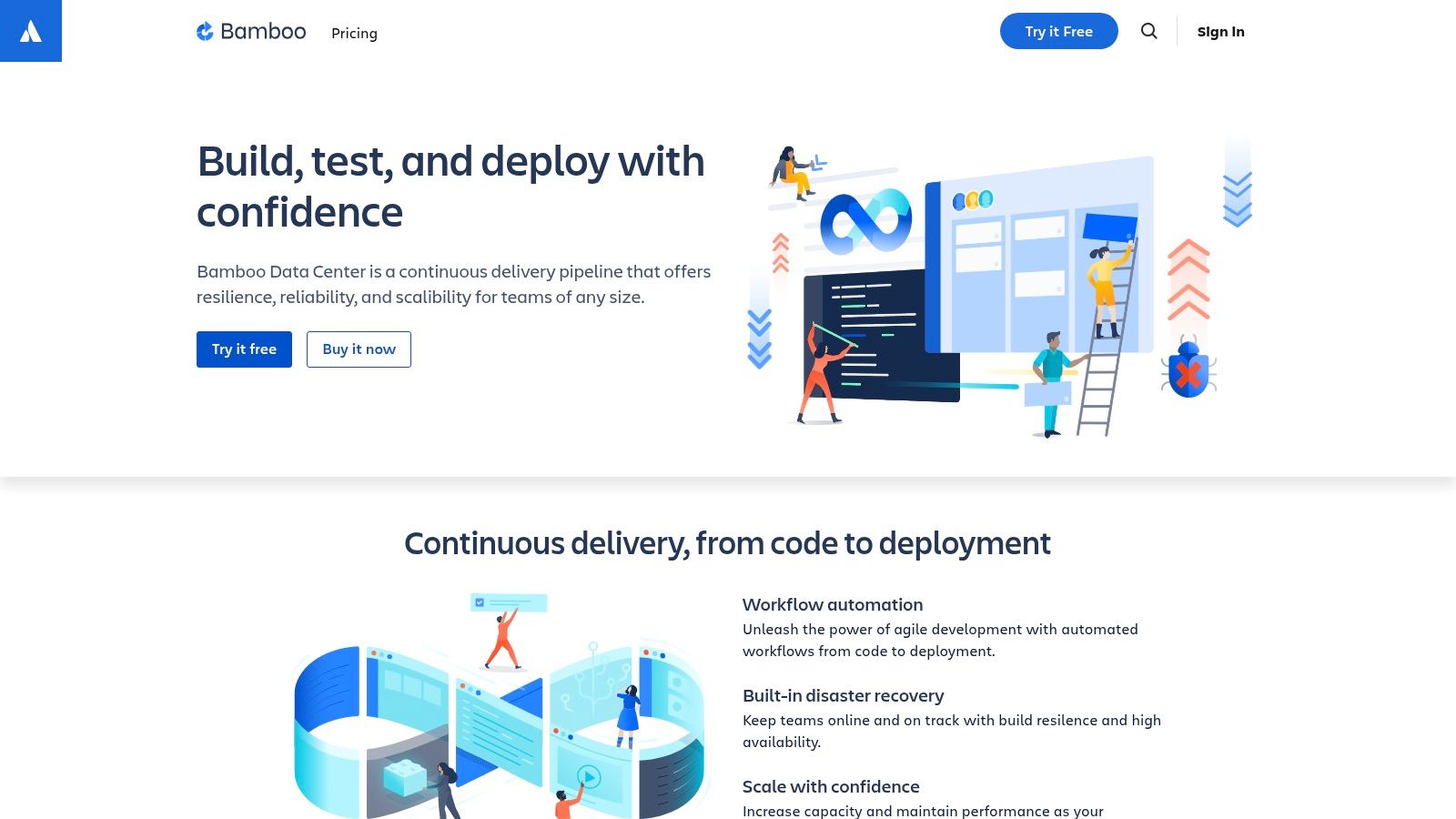
Bamboo allows development teams to create multi-stage build plans, dividing the software delivery process into distinct stages like building, testing, and deploying. Each stage can consist of multiple jobs, which are individual tasks performed within a stage. This granular control allows for fine-tuning the CI/CD pipeline and optimizing for speed and efficiency. Furthermore, Bamboo excels at release management, with "deployment projects" that enable automating deployments to various environments like staging, testing, and production. This feature streamlines the release process and reduces the risk of errors during deployments. This detailed workflow structure distinguishes Bamboo from some competitors, enabling advanced automation capabilities, complex deployments, and better control over the entire CI/CD pipeline.
One of Bamboo's key strengths is its deep integration within the Atlassian ecosystem. Teams already using Jira can link build results, deployments, and code changes directly to Jira issues, providing complete traceability and simplifying project management. Similarly, integration with Confluence allows teams to automatically publish build reports and release notes, further enhancing collaboration and communication. For teams heavily invested in the Atlassian suite, this seamless integration provides significant advantages in terms of workflow efficiency and data centralization. This makes Bamboo an especially compelling continuous delivery tool for those organizations.
Bamboo provides built-in support for Git branching workflows, allowing developers to easily create branches for features, bug fixes, or releases. Bamboo automatically detects changes on these branches and triggers builds accordingly, ensuring continuous integration across different development streams. The ability to define specific triggers for different branches and environments allows for a high degree of flexibility and control. For example, you can configure Bamboo to automatically deploy changes from the develop branch to a staging environment, while releases from the main branch are deployed to production after successful testing.
While Bamboo offers many benefits, it also has some drawbacks. Compared to open-source alternatives like Jenkins, Bamboo's licensing can be expensive, especially for larger teams. While the server deployment option provides flexibility and control, the discontinuation of the cloud version might be a limiting factor for some organizations. Additionally, the plugin ecosystem, although substantial, is less extensive than Jenkins, potentially requiring custom development for certain integrations. Finally, community support, while available, is not as widespread as with open-source alternatives.
Pricing: Bamboo is licensed based on "remote agents." Pricing tiers are available based on the number of remote agents needed, scaling up to accommodate larger teams and build requirements. Consult the Atlassian website for the most up-to-date pricing information.
Technical Requirements: Bamboo Server requires a dedicated server or virtual machine running a supported operating system (Linux, Windows, or macOS). Specific hardware requirements depend on the scale of your CI/CD pipeline and the number of builds being processed. Detailed system requirements are available on the Atlassian documentation website.
Implementation Tips:
- Start with a pilot project: Before fully migrating to Bamboo, start with a small pilot project to familiarize your team with the tool and its features.
- Leverage the Atlassian integration: If your team uses Jira and Confluence, make full use of the integration features for enhanced traceability and collaboration.
- Plan your build stages and jobs carefully: A well-structured build plan is crucial for efficient CI/CD. Clearly define the stages and jobs within your pipeline to optimize the build process.
- Utilize deployment projects for release management: Take advantage of Bamboo's deployment projects to automate and streamline your release process.
Comparison with Jenkins: While both Bamboo and Jenkins are powerful CI/CD tools, they differ in several key aspects. Bamboo offers a more user-friendly interface and tighter integration with the Atlassian ecosystem, while Jenkins boasts a larger plugin ecosystem and a vast open-source community. The choice between the two often depends on the specific needs and preferences of the organization.
For more information and detailed documentation, visit the official Bamboo website: https://www.atlassian.com/software/bamboo
10. Spinnaker
Spinnaker is a powerful, open-source, multi-cloud continuous delivery platform specifically designed for managing complex deployments across a variety of cloud providers. Originally developed by Netflix to handle their massive scale and frequent release cycles, Spinnaker has become a popular choice for organizations looking for a robust and flexible continuous delivery solution. Its strength lies in its sophisticated deployment orchestration capabilities, advanced deployment strategies, and inherent support for multiple cloud environments. This makes it a valuable tool for software development teams, DevOps engineers, and enterprise IT leaders seeking a robust solution for automating and managing their release pipelines. Spinnaker firmly earns its place on this list of top continuous delivery tools due to its mature feature set, multi-cloud flexibility, and focus on advanced deployment strategies.
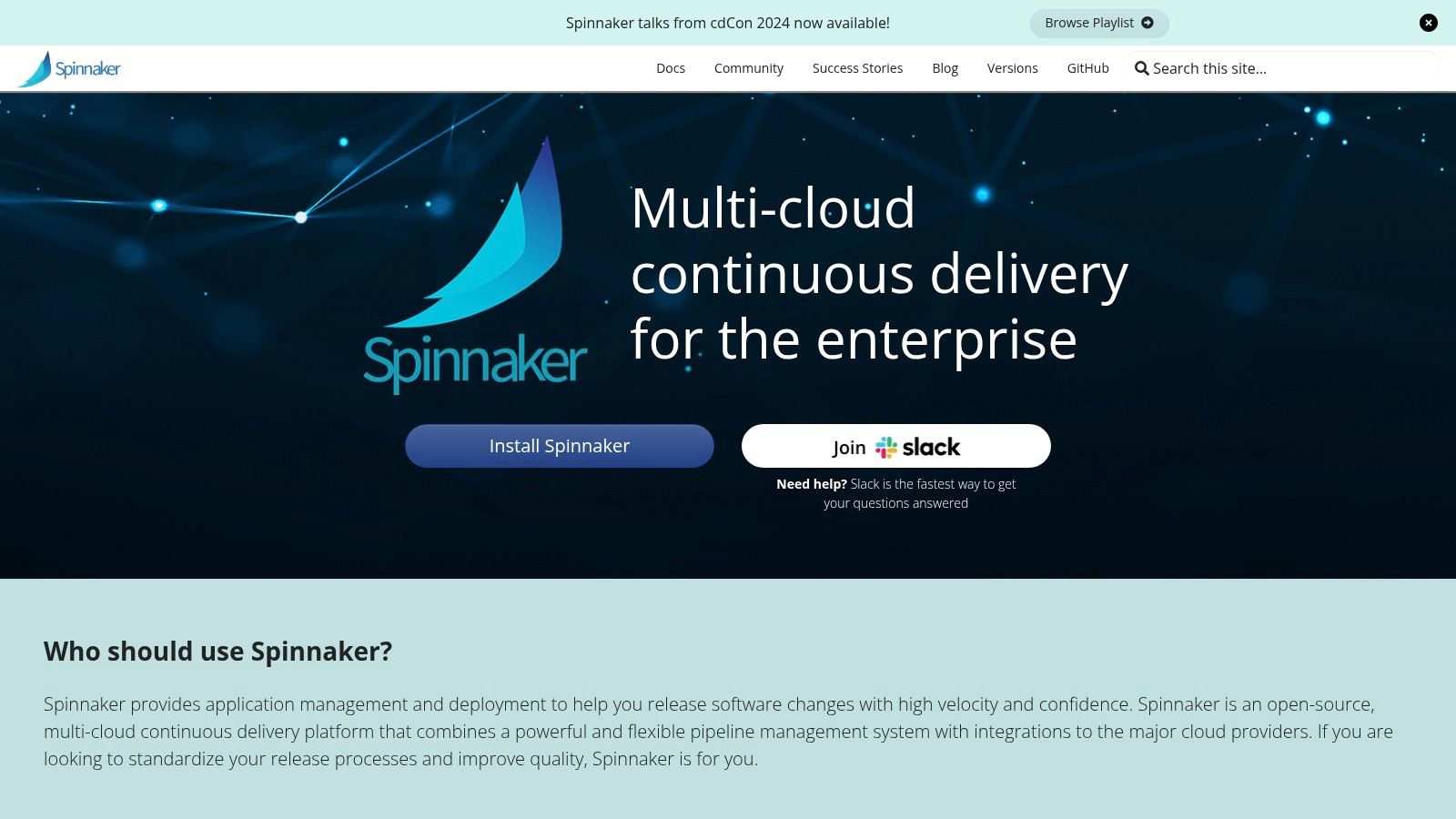
One of Spinnaker's key differentiators is its robust multi-cloud support. It seamlessly integrates with major cloud providers including AWS, Google Cloud Platform (GCP), Microsoft Azure, and Kubernetes, enabling organizations to manage deployments across a heterogeneous infrastructure. This multi-cloud capability is crucial for organizations adopting a hybrid or multi-cloud strategy, providing a single pane of glass for managing deployments across all environments. Spinnaker also excels in its support for sophisticated deployment strategies such as blue/green deployments, canary releases, and rolling updates. These strategies allow for safer and more controlled releases, minimizing downtime and mitigating the risk of deployment failures. Blue/green deployments, for example, involve deploying a new version of the application alongside the existing version, switching traffic over once the new version is validated. Canary releases, on the other hand, involve gradually rolling out a new version to a small subset of users, monitoring its performance before releasing it to the wider audience.
Spinnaker's application and cluster management interface provides a centralized location for managing applications and their underlying infrastructure. This simplifies the management of complex deployments, allowing teams to monitor the status of deployments, rollback to previous versions if necessary, and manage the underlying infrastructure resources. The platform also employs a "pipeline-as-code" approach using JSON for configuration, enabling infrastructure automation and version control for deployment pipelines. This allows for reproducible and auditable deployments, promoting consistency and reducing the risk of human error. Automated rollback capabilities and built-in safety checks further enhance the reliability and safety of the deployment process. Spinnaker can automatically revert to a previous version if issues are detected during deployment, minimizing the impact of failed deployments.
While Spinnaker offers powerful capabilities, it's essential to be aware of its complexity. Setting up and configuring Spinnaker can be a challenging undertaking, requiring significant technical expertise and familiarity with cloud infrastructure. The learning curve is steep, and while the documentation has improved, it can still be a challenge to find specific information or troubleshooting guidance. Furthermore, Spinnaker is a resource-intensive platform, requiring substantial infrastructure resources to operate effectively. This can be a significant cost consideration, particularly for smaller organizations.
Compared to other continuous delivery tools like Jenkins or Argo CD, Spinnaker distinguishes itself with its focus on multi-cloud deployments and advanced deployment strategies. Jenkins, while highly versatile, requires more manual configuration and integration to achieve similar multi-cloud capabilities. Argo CD, on the other hand, excels in Kubernetes-native deployments but may lack the breadth of multi-cloud support offered by Spinnaker.
For teams considering implementing Spinnaker, it's recommended to start with a small pilot project to familiarize themselves with the platform and its complexities. Leveraging pre-built configurations and community resources can help streamline the initial setup process. Investing in training and development for the team is crucial for successful adoption and ongoing management of the platform. Spinnaker's official website (https://spinnaker.io/) provides valuable resources, including documentation, tutorials, and community forums. Despite the complexities, Spinnaker's powerful capabilities and multi-cloud flexibility make it a compelling choice for organizations seeking a robust continuous delivery platform for managing sophisticated deployments. Being open-source with no licensing costs further adds to its appeal, making it a viable option even for organizations with budget constraints.
Continuous Delivery Tools Feature Comparison
| Platform | Core Features/Characteristics | User Experience/Quality ★ | Value Proposition 💰 | Target Audience 👥 | Unique Selling Points ✨ |
|---|---|---|---|---|---|
| 🏆 Mergify | Intelligent merge queue, CI batching, AI-driven CI Insights | ★★★★★ | Saves CI costs, boosts developer efficiency 💰💰 | DevOps teams, startups, enterprises 👥 | AI-based CI insights, flexible merge scheduling, automated conflict reduction |
| Jenkins | Open-source, 1800+ plugins, pipeline-as-code | ★★★★☆ | Free, highly customizable 💰 | DevOps engineers, large teams 👥 | Massive plugin ecosystem, platform-agnostic |
| GitLab CI/CD | Integrated DevOps platform, Auto DevOps, security scanning | ★★★★☆ | All-in-one platform, free tier 💰 | DevOps teams, enterprises 👥 | Built-in container registry, Kubernetes support |
| Azure DevOps | Azure Pipelines, multi-platform, Azure ecosystem integration | ★★★★☆ | Strong MS integration, free tier 💰 | Microsoft-centric teams, enterprises 👥 | Comprehensive DevOps suite, Azure integration |
| GitHub Actions | Native to GitHub, marketplace actions, matrix builds | ★★★★☆ | Generous free tier, easy setup 💰 | GitHub users, small to mid teams 👥 | Seamless GitHub integration, large action marketplace |
| CircleCI | Cloud-native, advanced caching, Docker-first | ★★★★☆ | Good free tier, fast builds 💰 | Modern dev teams, container users 👥 | Fast build speeds, reusable orbs |
| TeamCity | On-premises, intelligent build chains, JetBrains IDEs | ★★★★☆ | Free up to 100 builds, licensed 💰 | Enterprises, JetBrains users 👥 | Advanced build management, strong IDE integration |
| AWS CodePipeline | AWS native, visual pipeline, multi-strategy deployment | ★★★☆☆ | Pay-per-use, AWS ecosystem 💰 | AWS customers, cloud teams 👥 | Deep AWS integration, serverless pipeline management |
| Bamboo | Atlassian integration, Git workflows, deployment projects | ★★★☆☆ | Enterprise-focused, licensed 💰 | Atlassian users, enterprises 👥 | Tight Jira/Confluence integration, enterprise security |
| Spinnaker | Multi-cloud, advanced deployment strategies | ★★★☆☆ | Open-source, no license cost 💰 | Large orgs, multi-cloud teams 👥 | Multi-cloud deployments, blue-green & canary strategies |
Choosing Your Perfect Continuous Delivery Tool
Selecting the right continuous delivery tools from the options presented—Mergify, Jenkins, GitLab CI/CD, Azure DevOps, GitHub Actions, CircleCI, TeamCity, AWS CodePipeline, Bamboo, and Spinnaker—is crucial for optimizing your software development lifecycle. The most important takeaway is that there's no one-size-fits-all solution. Your ideal tool depends on a variety of factors, including your team's size and experience, the complexity of your projects, budget constraints, and existing infrastructure. Key considerations include cloud integration capabilities, containerization needs, and how well the tool supports your team's collaboration preferences.
Remember to carefully evaluate the specific requirements of your projects. For instance, if you're working with microservices, a tool that excels in container orchestration and deployment, like Spinnaker, might be a good fit. If you're focused on a streamlined GitHub workflow, GitHub Actions might be the more natural choice. For specialized cleaning needs in manufacturing or other industries, there are also niche continuous delivery solutions. For example, you can use portable laser cleaning machines for precise and efficient material removal during production. Investing time in thorough research and testing will pay dividends in the long run by ensuring a smooth and efficient continuous delivery pipeline.
By carefully weighing these factors and exploring the continuous delivery tools we’ve covered, you can empower your team to build, test, and deploy software more efficiently and reliably. Implementing the right continuous delivery tools can significantly reduce manual effort, minimize errors, and accelerate your release cycles, ultimately enabling you to deliver value to your users faster.
Streamline your GitHub workflow and enhance your continuous delivery pipeline with powerful merge automation. Explore how Mergify can simplify your development process and boost your team's productivity.





